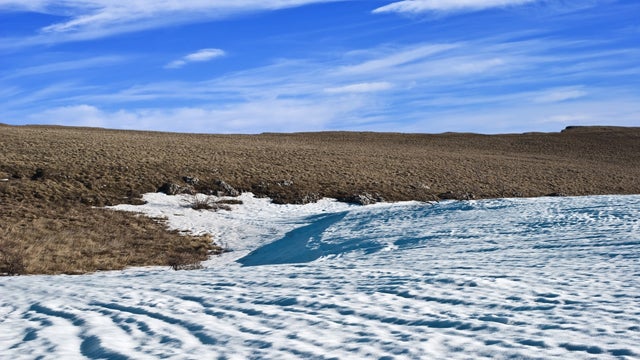New research done for Protect Our Winters and the Natural Resources Defense Council puts dollar signs on something we already know: climate change is killing the snow sports industries.

Jeremy Jones and Chris Steinkamp, founder and executive director,
respectively, of the snow sports environmental activism organization ,
have been making annual pilgrimages to Washington, D.C., to ask
legislators to support climate change bills. The ski and snowboard
industries, they've explained, are extremely vulnerable to a warming
planet.
“What they told us,” says Steinkamp, “Is 'Great, but we can't do
anything until we see the facts. We need some ammo.' The anecdotal
[evidence]
that athletes gave us [wasn't] enough.”
The first round of that ammunition was released today, in the form of a report that forecasts significantly depleted snowpacks in many parts of the U.S. by the end of the century and ties these forecasts to business implications for the snow sports industry.
Low-snow years between 1999 and 2010 already led to the loss of around 13,000 jobs and 15 million fewer skier visits to resorts. “The difference between a good snow year and a bad year is between $800 million to $1.9 billion in reduced economic activity in the U.S.,” says Matt Magnusson, the report's co-author and an adjunct lecturer for the University of New Hampshire.
With forecasts showing a warming trend of four to 10 degrees Fahrenheit in winter temperatures by the end of the century, with less snowfall and a shorter snow season, the number of jobs lost between a good and a bad snow year could grow to 27,000.
During a call with reporters, Auden Schendler, vice president of sustainability for Aspen Ski Company, didn't mince words. “The ski and snowboard industry has known for years that climate change threatens the existence of the business,” he said. “This report puts financial metrics behind that change. The solution should be for ski industry leaders and trade group leaders to get off their asses and move as if this were an existential threat to their business, which is what it is.”
While much of the data in the report is based on the alpine ski and snowboard resort industry, it also notes that, nation-wide, snowmobile registrations have been flat since 2000. The dependence on natural (versus man-made) snow puts snowmobiling at particular risk, the authors noted.
Tourism linked to ski resorts and snowmobiling adds $12.2 billion to the U.S. economy, the report says.
“A bad snow season hits the economy of three quarters of U.S. states,” says Antonia Herzog, assistant director of the NRDC's Climate and Clean Air Program. “Some resorts can adapt better than others, but none are immune. Low-snow years translate to fewer skier visits, and that translates into money. People's livelihoods, jobs, and lifestyles are going to be affected.”
The report arrives following the fourth warmest winter on record, during which about half of the ski areas in the United States opened late and closed early. But that followed the massive snowfall of 2010-2011, so it can be hard to focus on trends rather than individual seasons.
“There is a sliver of time between now and the end of the century when we can end up with winters like 2011,” says report co-author Elizabeth Burakowski, who measures and models winter climate as a Ph.D. candidate at the University of New Hampshire. “It's not like we're saying the snow is going to end tomorrow … but by end of century, unless we take action now, the climate is going to change the [snow sports] industry.”
Steinkamp says he hopes the report will help galvanize the snow sports industries. “Hopefully it will change the dialogue,” he says, and push the ski industry trade groups to take more action. “The National Ski Area Association has done great work at the resort level, but they're not doing any lobbying for the climate.” He notes that state-based ski tourism groups also need to act, but that trade groups do what their members tell them to do, so the onus is also on resort owners.
“I'm not a resort owner so I can't throw stones, but it's a matter of being able to operate for the next 10-15 years versus for the next 100 years,” Steinkamp says. He points to one study that shows snowpack in the Cascades and Sierra Nevada could fall by 70 percent by 2050. “That's within my kid's lifespan,” he says, “Which makes it all real.”
The NRDC and POW will bring the report to legislators as a means of amplifying their messages that carbon emissions must be addressed at the national level.
“I'm hoping that this report is going to drive radical change. The change is not in reducing the carbon footprint at individual resorts, which is fine, but in getting to Washington [D.C.] and making aggressive public statements, writing op-eds, educating the industry as a whole,” says Schendler. The industry's 21 million participants also have an important role, he adds, “to drive the critical policy change so we can ski for the next 100 years.”
You can download the .
—Mary Catherine O'Connor